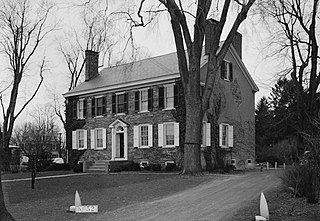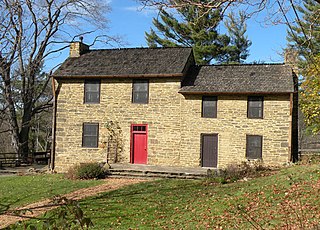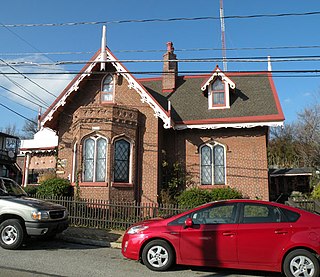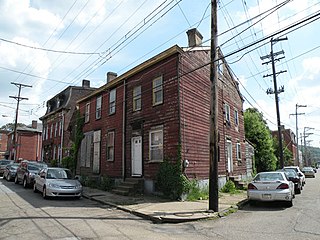
The Allegheny Portage Railroad was the first railroad constructed through the Allegheny Mountains in central Pennsylvania. It operated from 1834 to 1854 as the first transportation infrastructure through the gaps of the Allegheny that connected the midwest to the eastern seaboard across the barrier range of the Allegheny Front. Approximately 36 miles (58 km) long overall, both ends connected to the Pennsylvania Canal, and the system was primarily used as a portage railway, hauling river boats and barges over the divide between the Ohio and the Susquehanna Rivers. Today, the remains of the railroad are preserved within the Allegheny Portage Railroad National Historic Site operated by the National Park Service.

Allegheny Cemetery is one of the largest and oldest burial grounds in Pittsburgh, Pennsylvania. It is a historic rural cemetery.

Union Station, also known as Pennsylvania Station and commonly called Penn Station, is a historic train station in Downtown Pittsburgh, Pennsylvania. It was one of several passenger rail stations that served Pittsburgh during the 20th century; others included the Pittsburgh & Lake Erie Railroad Station, the Baltimore and Ohio Station, and Wabash Pittsburgh Terminal, and it is the only surviving station in active use.

Nicodemus National Historic Site, located in Nicodemus, Kansas, United States, preserves, protects and interprets the only remaining western town established by African Americans during the Reconstruction Period following the American Civil War. The town of Nicodemus is symbolic of the pioneer spirit of African Americans who dared to leave the only region they had been familiar with to seek personal freedom and the opportunity to develop their talents and capabilities. The site was named, at least in part, for a legendary African-American slave featured in abolitionist Henry Clay Work's "Wake, Nicodemus (1864)." It is a mystical story of an old slave died away and buried in a hollow tree who had asked to be awakened on the Day of Jubilee.

Fort Mifflin, originally called Fort Island Battery and also known as Mud Island Fort, was commissioned in 1771 and sits on Mud Island on the Delaware River below Philadelphia, Pennsylvania near Philadelphia International Airport.

Lawrenceville is one of the largest neighborhood areas in Pittsburgh in the U.S. state of Pennsylvania. It is located northeast of downtown, and like many of the city's riverfront neighborhoods, it has an industrial past. The city considers Lawrenceville three neighborhoods, Upper Lawrenceville, Central Lawrenceville, and Lower Lawrenceville, but these distinctions have little practical effect. Accordingly, Lawrenceville is almost universally treated as being a single large neighborhood.

The Allegheny County Courthouse in downtown Pittsburgh, Pennsylvania, is part of a complex designed by H. H. Richardson. The buildings are considered among the finest examples of the Romanesque Revival style for which Richardson is well known.

West Overton is located approximately 40 miles (64 km) southeast of Pittsburgh, in East Huntingdon Township, Westmoreland County, Pennsylvania, United States. It is on PA 819 between the towns of Mount Pleasant and Scottdale. Its latitude is 40.117N and its longitude is -79.564W.

The Ybor City Historic District is a U.S. National Historic Landmark District located in Tampa, Florida. The district is bounded by 6th Avenue, 13th Street, 10th Avenue and 22nd Street, East Broadway between 13th and 22nd Streets. Ybor City contains a total of 956 historic buildings, including an unparalleled collection of architecture with Spanish-Cuban influence, as well as historic cigar factory buildings and associated infrastructure. The area was developed by businessman Vicente Martinez Ybor beginning in 1886, and was for a time the world's leading supplier of cigars.

The Philadelphia Quartermaster Depot, now known as the Defense Logistics Agency Troop Support, was founded as the Schuylkill Arsenal in 1799.

The Brady Street Bridge, also known as the South 22nd Street Bridge, was a steel bowstring arch bridge in Pittsburgh, Pennsylvania, which crossed over the Monongahela River at South 22nd Street. Its main span was a tied arch with a suspended road deck, with two through-truss side spans, carrying two traffic lanes between Brady Street on the Pittsburgh side and South 22nd Street on the south side. Approach viaducts were built at either end. The bridge was built by the Schultz Bridge and Iron Company.

Lawrence Township Historic District is a historic district that preserves the community of Lawrence Township, Mercer County, New Jersey, United States.

Allegheny Post Office, also known as Old North Post Office, The Landmarks Museum, is a building built in 1897 in the Allegheny City area that is now within Pittsburgh, Pennsylvania. It is located in Pittsburgh's North Side.

Oliver Miller Homestead, site of the James Miller House, is a public museum that commemorates pioneer settlers of Western Pennsylvania. It is located in Allegheny County, Pennsylvania's South Park 10 miles (16 km) south of downtown Pittsburgh in South Park Township.

The Washington Crossing Bridge, commonly known as the Fortieth Street Bridge, is an arch bridge that carries vehicular traffic across the Allegheny River between the Pittsburgh neighborhood of Lawrenceville and the suburb of Millvale.

The Byers-Lyons House in the Allegheny West neighborhood of Pittsburgh, Pennsylvania, is a building from 1898. It was added to the List of City of Pittsburgh historic designations on March 15, 1974, the National Register of Historic Places on November 19, 1974, and the List of Pittsburgh History and Landmarks Foundation Historic Landmarks in 1989.

The Heathside Cottage in the Fineview neighborhood of Pittsburgh, Pennsylvania is a Gothic Revival structure built between 1864 and 1866 for the family of stonemason and civil engineer James Andrews. It was listed on the National Register of Historic Places in 1974.

184 38th Street, also known as McBride Log House, was a historic log house in the Lawrenceville neighborhood of Pittsburgh, Pennsylvania. Before its demolition, it was thought to be the oldest log house in any major American city to be used as a residence.

The Turney House is a historic house in the Lawrenceville neighborhood of Pittsburgh, Pennsylvania, and a designated Pittsburgh historic landmark. It was built circa 1851 by Lucian B. Turney, a carpenter who also served on the Lawrenceville Borough Council during the 1850s. It was also the residence of Turney's daughter Margaret, who at age 17 was one of 78 workers killed in the 1862 Allegheny Arsenal Explosion, the deadliest civilian disaster during the U.S. Civil War. After the demolition of 184 38th Street in 2011, the Turney House is the only surviving house known to be associated with a victim of the explosion. Another one of Turney's children, Olive, became a successful artist. In 1996, the house was purchased by architectural historian Carol Peterson, who restored it to a period-appropriate appearance.
Two buildings in Pittsburgh were known as the United States Marine Hospital. They were part of the U.S. Marine Hospital system, which was run by the Marine Hospital Service and its successor the Public Health Service, primarily for the benefit of the civilian merchant marine. The original hospital was located in Allegheny City and was used as a Marine Hospital during 1851–1875, after which it was sold. It was demolished in the late 1880s for construction of the Ohio Connecting Railroad Bridge.
























